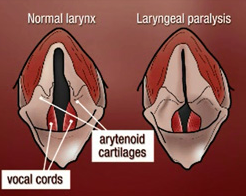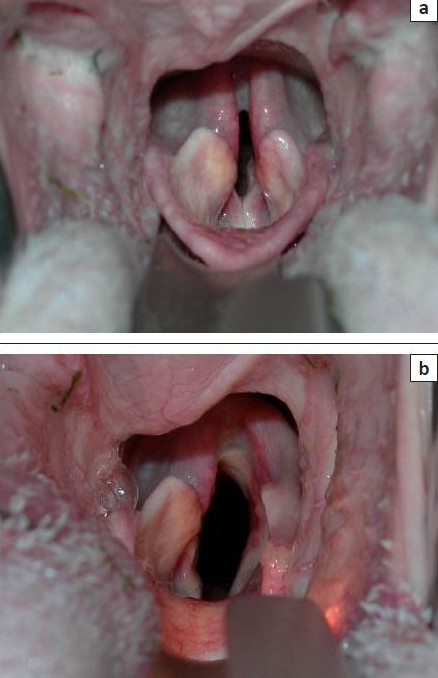Last week you learned from Dr. Odunayo some wonderfully helpful tips to keep your pets safe in the summer months. You may remember her comments about taking steps to help animals, particularly dogs, acclimatize effectively to warmer weather. Some dogs have more trouble than others adjusting to increased heat and humidity because their voice boxes no longer function properly. This condition is called laryngeal paralysis or “lar par” and can be life-threatening if not treated appropriately. This week I present information about this ailment to increase awareness of this common condition. Happy reading!
Laryngeal paralysis: What is it?
The larynx (often called the voice box) is an important part of the respiratory tract. When dogs breathe in (inhale), muscles of the larynx (pronounced lare-inks; not lare-nix) open the entrance to the windpipe (trachea); these muscles subsequently relax when the pets breathe out (exhale).

For patients with laryngeal paralysis, these intricate muscles simply don’t work properly. So when affected dogs inhale, the entrance to the trachea remains narrow and can even shut completely in severely affected pets.
Laryngeal paralysis can affect one or both sides of the voice box. Pets can be born with this condition or they can develop it later in life. Congenital laryngeal paralysis has been documented in several breeds, including Bouvier des Flandres, Siberian Husky, and Bull Terriers. For dogs with the acquired form of the disease, we often never determine what caused it – this is called idiopathic laryngeal paralysis. Male dogs are slightly over-represented compared to female ones, and affected dogs are usually geriatric. Over-represented dog breeds with acquired laryngeal paralysis are:
- Labrador Retriever
- Saint Bernard
- Golden Retriever
- Newfoundland
- Afghan Hound
- Standard Poodle
- German Shepherd
Less common causes of acquired laryngeal paralysis are damage to the major nerve (called the recurrent laryngeal nerve) that goes to the voice box, neck/throat trauma, and non-traumatic nerve and muscle disorders. Hypothyroidism and hypoadrenocorticism (also called Addison’s disease where the adrenal glands don’t function properly) have been associated with laryngeal paralysis.
Laryngeal paralysis: What does it look like?
The clinical signs associated with laryngeal paralysis are variable and dependent on how progressed the condition is an affected patient. Evidence of “lar par” can be quite subtle early in the course of the disease, and includes a change in bark and harsh or increased panting in calm cool non-humid environments.
Remember panting is a very important mechanism by which dogs eliminate heat from the body. If the larynx is paralyzed, affected pets can’t rid the body of heat efficiently, and thus they are at-risk for overheating. Combined with inadequate acclimatization, the warmer and more humid summer months unquestionably pose a threat to patients living with laryngeal paralysis.
Affected pets become intolerant of their normal exercise routines as laryngeal paralysis progresses. They don’t want to play as much or walk as far. Dogs develop a characteristic breathing noise called stridor that results from turbulent air passing through a dysfunctional larynx. Click the videos below to hear stridor in dogs.
Severely affected dogs truly develop life-threatening difficulty breathing. They have to work harder to breathe in and out, and they become exceedingly anxious which can exacerbate trouble breathing. When pets don’t get enough oxygen, their gums and tongue quickly turn blue/purple (called cyanosis) and they resent handling and restraint; these pets need immediate veterinary medical attention!
Laryngeal paralysis: How is it diagnosed?
Diagnosis of laryngeal paralysis requires a veterinarian to visually inspect a pet’s larynx. As I mentioned earlier, a paralyzed larynx does not open adequately when an affected pet inhales. To properly evaluate the larynx, a pet must be sedated with just enough medication to allow a veterinarian to look in the back of throat without having the sedative affect the muscles of the larynx. Click the videos below to see sedated laryngeal examinations of dogs with laryngeal paralysis.
Prior to sedation, a veterinarian should ideally perform some blood and urine tests to ensure the administration of sedation is safe. However this testing is not always possible in patients presented with respiratory distress, as examining the larynx and helping the patient breathe with increased ease by placing a tube through the mouth into the windpipe (called endotracheal intubation) is critically essential. This process is often called ‘capturing the airway’ and should be performed as quickly as possible in patients have trouble breathing. Screening for hypothyroidism and Addison’s disease in patients with laryngeal paralysis is important.
Laryngeal paralysis: How is it treated?
The type of intervention needed for patients living with laryngeal paralysis depends on the how far advanced the disease is. Dogs with minimal clinical signs frequently only require minor lifestyle adjustments such as:
- Avoiding collars / only using harnesses
- Maintaining a healthy weight
- Avoiding exercise in warm and humid conditions.
Patients with moderate evidence of disease often require marked exercise restriction, cooling measures, and occasional sedation, particularly during periods of stress and excitement. Additionally a drug called doxepin has been used successfully in some affected dogs to help reduce the severity of clinical signs of laryngeal paralysis.
Ultimately idiopathic laryngeal paralysis is a progressive condition, and medical management will become ineffective. A surgery called arytenoid lateralization (also referred to as a “tieback”) is recommended for those patients who stop responding to medical therapies. This surgery is minimally invasive and relatively straightforward, especially when performed by a board-certified veterinary surgeon.

Other surgical options are available if a “tieback” is not an option or considered appropriate, and a veterinary surgical specialist can discuss all of them with you. The most significant surgical complication in patients with laryngeal paralysis is aspiration of fluid into the lungs; other potential complications include:
- Persistent coughing after drinking
- Fragmentation of laryngeal cartilage
- Breakdown of the suture used in surgery
- Incisional complications like seroma formation (fluid pocket under the incision)
The vast majority of pets treated with arytenoid lateralization for laryngeal paralysis experience an immediate and meaningful improvement in ease of breathing.
The take-away message about laryngeal paralysis…
Idiopathic laryngeal paralysis or “lar par” is a relatively condition in older dogs, particularly Labrador Retrievers. Definitive diagnosis requires direct visualization of a paralyzed voice box. Interventions can vary from minor lifestyle changes and medications to a minimally invasive surgery to improve airflow through the larynx. When surgery is needed, consultation with a board-certified veterinary surgeon is keenly helpful.
To find a board-certified veterinary surgeon, please visit the American College of Veterinary Surgeons.
To find a board-certified veterinary internal medicine specialist, please visit the American College of Veterinary Internal Medicine.
To find a board-certified veterinary emergency and critical care specialist, please visit the American College of Veterinary Emergency and Critical Care.
Wishing you wet-nosed kisses,
cgb




